Abstract
Chemicals, including commonly used drugs (e.g., penicillin, meprobamate, pyridium, and mercaptomerin) penetrate and persist for some time in the ovarian follicular fluid at concentrations approximately similar to that of the serum. Information as to the penetration of chemicals into the granulosa cells and into the oocyte is scanty, although there are some indications that these structures are also permeable to foreign chemicals. Similarly, caffeine, nicotine, thiopental, salicylic acid, antipyrine, barbital, and isoniazid enter the uterine secretion and penetrate the preimplantation blastocyst of mice, rats and rabbits. The pattern of distribution of compounds among ovarian follicular fluid, uterine luminal fluid, blastocyst and plasma varies from compound to compound and appears to be related to the molecular weight and degree of ionization of the compound and differs in pregnant and nonpregnant animals. Thus, nicotine and DDT accumulate in the uterine luminal fluid of pregnant but not in that of nonpregnant rabbits.
The penetration of foreign chemicals into the oocyte, uterine luminal fluid, and preimplantation blastocyst may exert adverse effects on fertilization, implantation, and/or further development of the conceptus. The possible toxicological importance of this process to eutherian reproduction is discussed.
Full text
PDF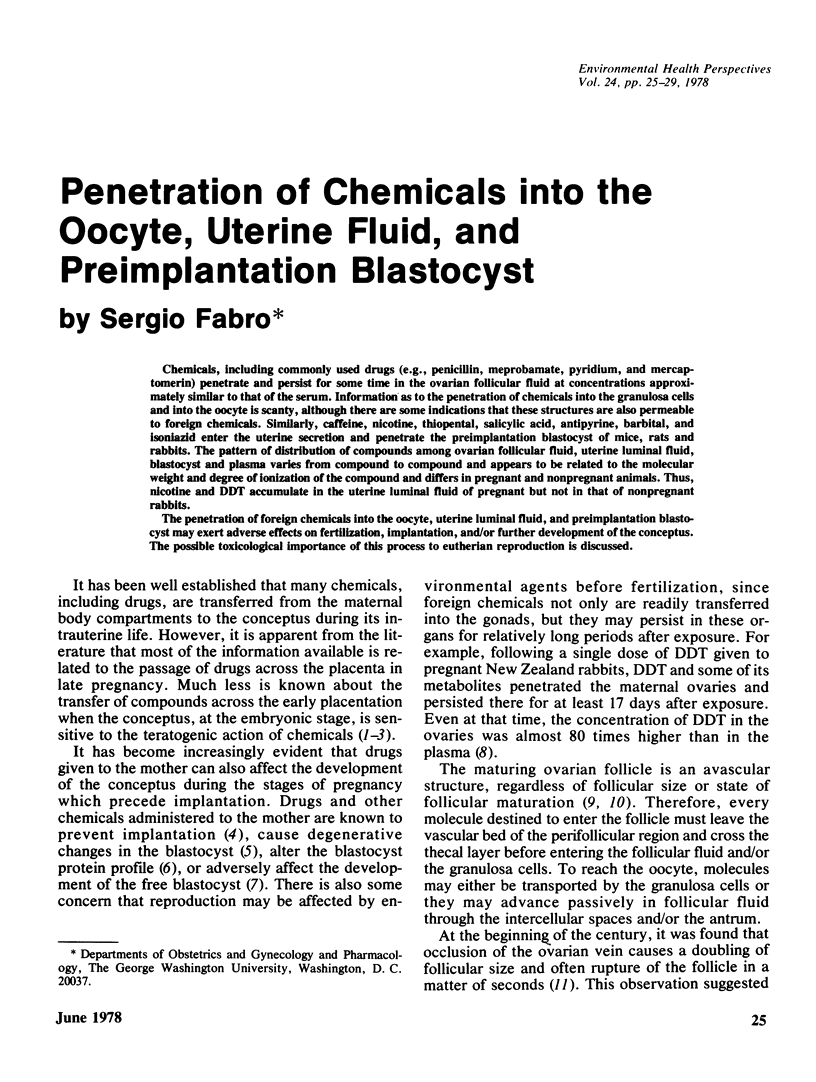
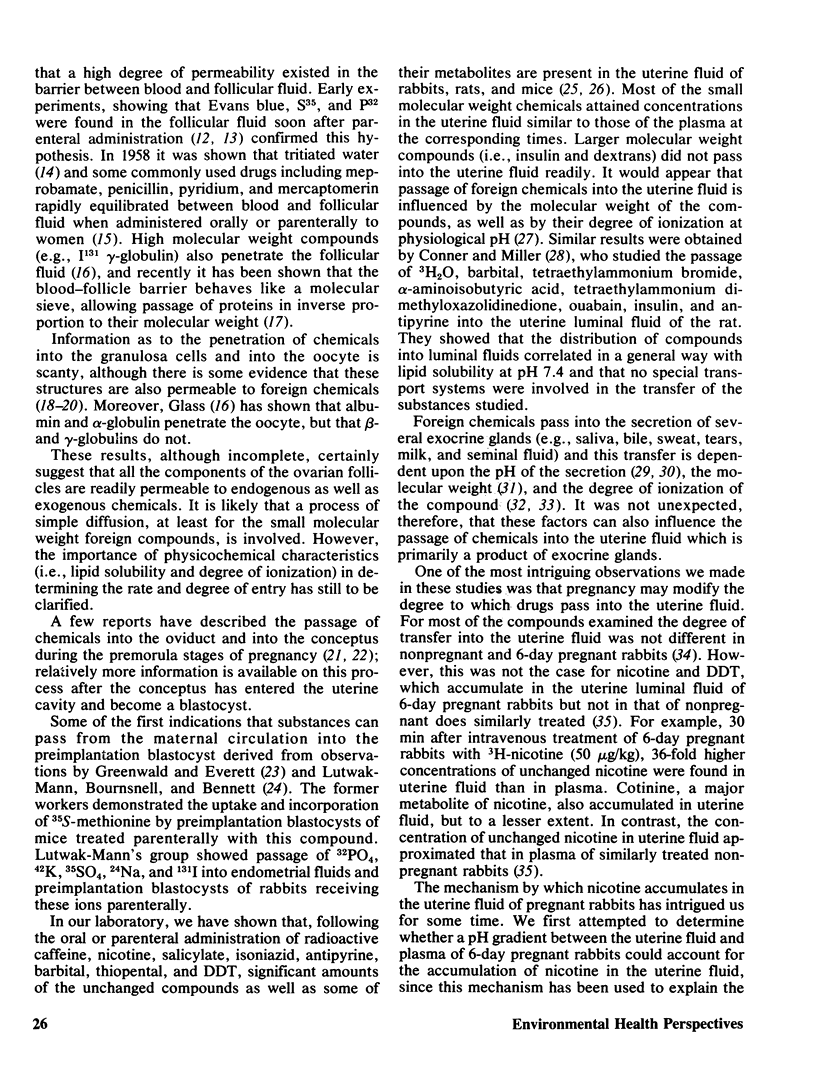
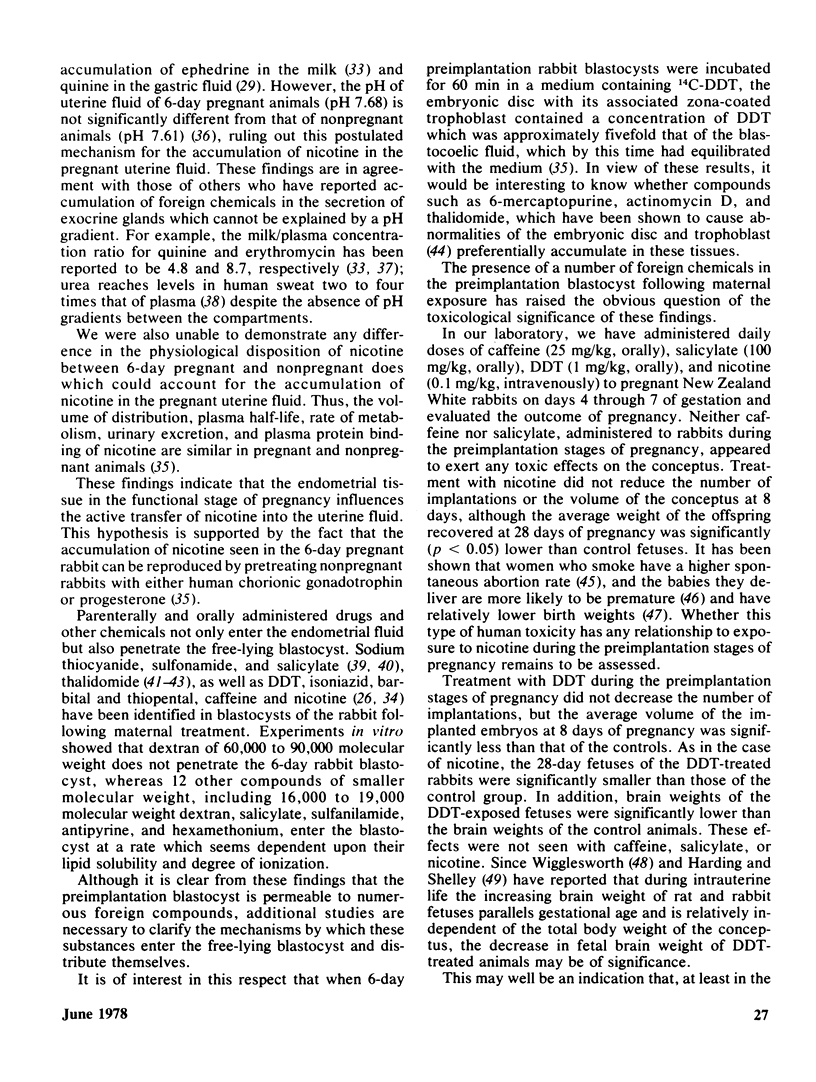
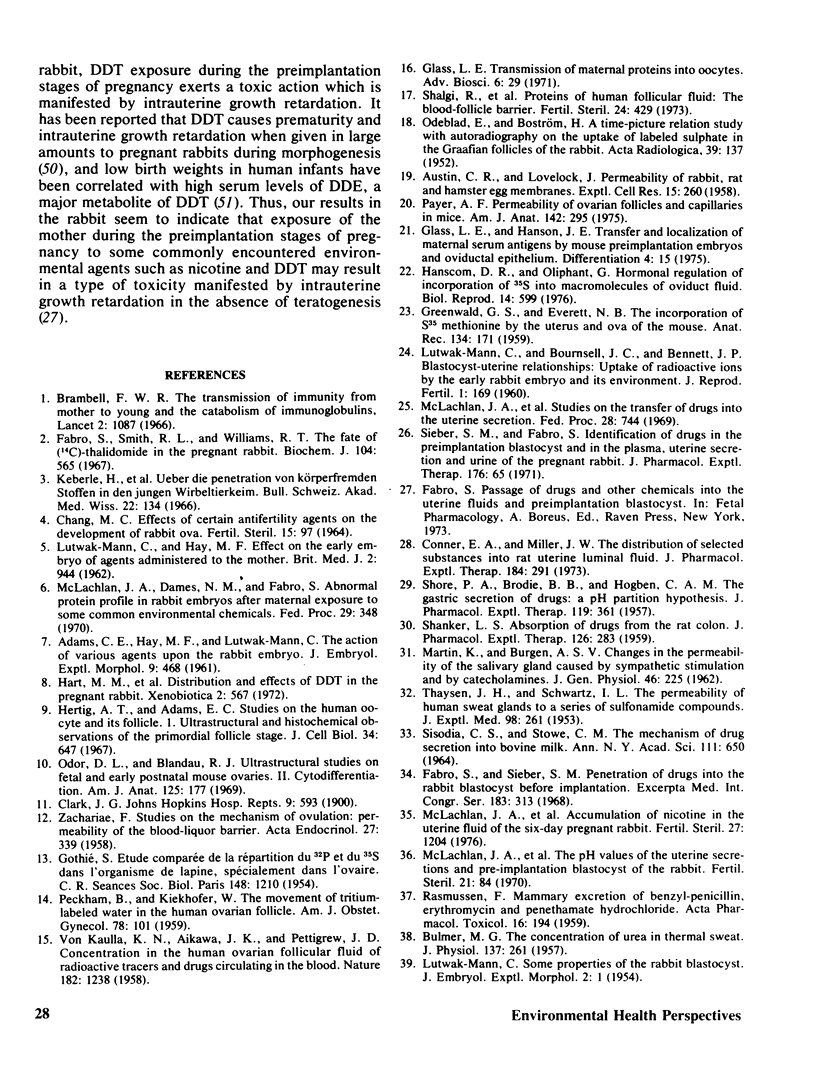
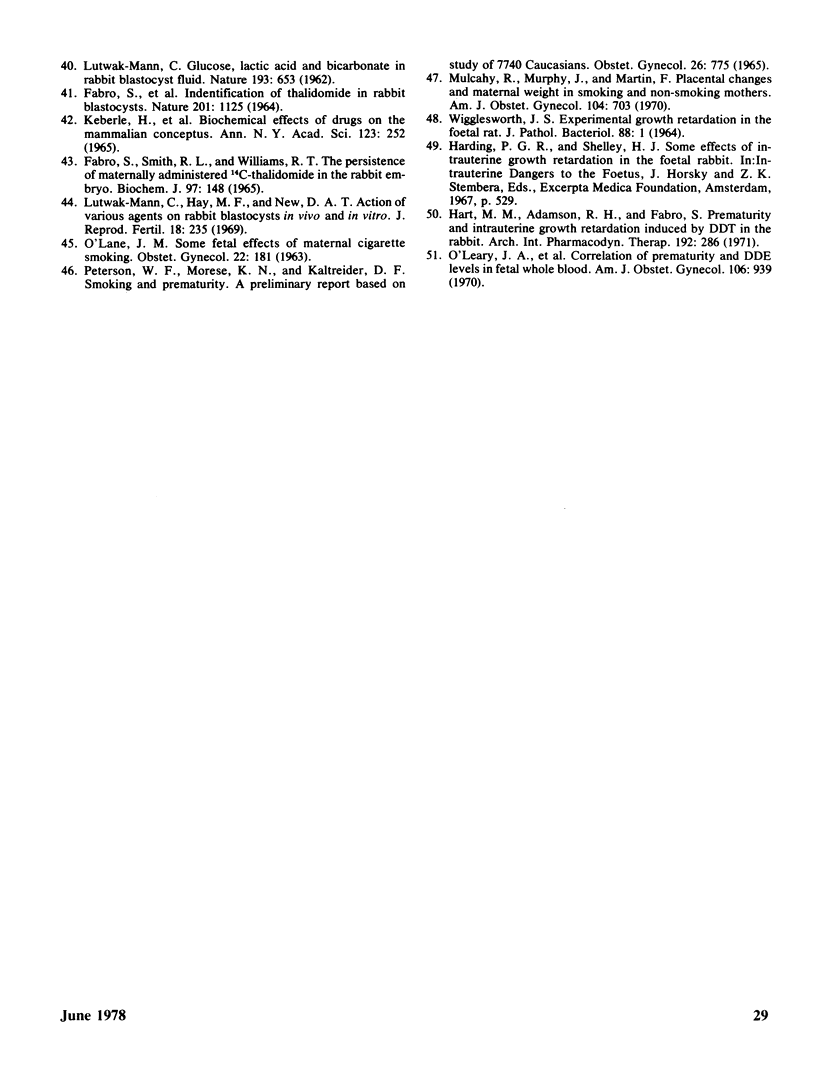
Selected References
These references are in PubMed. This may not be the complete list of references from this article.
- ADAMS C. E., HAY M. F., LUTWAK-MANN C. The action of various agents upon the rabbit embryo. J Embryol Exp Morphol. 1961 Sep;9:468–491. [PubMed] [Google Scholar]
- AUSTIN C. R., LOVELOCK J. E. Permeability of rabbit, rat and hamster egg membranes. Exp Cell Res. 1958 Aug;15(1):260–261. doi: 10.1016/0014-4827(58)90089-2. [DOI] [PubMed] [Google Scholar]
- BULMER M. G. The concentration of urea in thermal sweat. J Physiol. 1957 Jul 11;137(2):261–266. doi: 10.1113/jphysiol.1957.sp005810. [DOI] [PMC free article] [PubMed] [Google Scholar]
- Brambell F. W. The transmission of immunity from mother to young and the catabolism of immunoglobulins. Lancet. 1966 Nov 19;2(7473):1087–1093. doi: 10.1016/s0140-6736(66)92190-8. [DOI] [PubMed] [Google Scholar]
- CHANG M. C. EFFECTS OF CERTAIN ANTIFERTILITY AGENTS ON THE DEVELOPMENT OF RABBIT OVA. Fertil Steril. 1964 Jan-Feb;15:97–106. doi: 10.1016/s0015-0282(16)35113-5. [DOI] [PubMed] [Google Scholar]
- Conner E. A., Miller J. W. The distribution of selected substances into rat uterine luminal fluid. J Pharmacol Exp Ther. 1973 Jan;184(1):291–298. [PubMed] [Google Scholar]
- FABRO S., SCHUMACHER H., SMITH R. L., WILLIAMS R. T. IDENTIFICATION OF THALIDOMIDE IN RABBIT BLASTOCYSTS. Nature. 1964 Mar 14;201:1125–1126. doi: 10.1038/2011125a0. [DOI] [PubMed] [Google Scholar]
- Fabro S., Smith R. L., Williams R. T. The fate of[14C]thalidomide in the pregnant rabbit. Biochem J. 1967 Aug;104(2):565–569. doi: 10.1042/bj1040565. [DOI] [PMC free article] [PubMed] [Google Scholar]
- GOTHIE S. Etude comparée de la repartition du 32P et du 35S dans l'organisme de lapine, spécialement dans l'ovaire. C R Seances Soc Biol Fil. 1954 Jul;148(13-14):1210–1213. [PubMed] [Google Scholar]
- GREENWALD G. S., EVERETT N. B. The incorporation of S35 methionine by the uterus and ova of the mouse. Anat Rec. 1959 Jun;134:171–184. doi: 10.1002/ar.1091340205. [DOI] [PubMed] [Google Scholar]
- Glass L. E., Hanson J. E. Transfer and localisation of maternal serum antigens by mouse preimplantation embryos and oviductal epithelium. Differentiation. 1975 Sep 2;4(1):15–19. doi: 10.1111/j.1432-0436.1975.tb01437.x. [DOI] [PubMed] [Google Scholar]
- Hanscom D. R., Oliphant G. Hormonal regulation of incorporation of 35S into macromolecules of oviduct fluid. Biol Reprod. 1976 Jun;14(5):599–604. doi: 10.1095/biolreprod14.5.599. [DOI] [PubMed] [Google Scholar]
- Hart M. M., Adamson R. H., Fabro S. Prematurity and intrauterine growth retardation induced by DDT in the rabbit. Arch Int Pharmacodyn Ther. 1971 Aug;192(2):286–290. [PubMed] [Google Scholar]
- Hart M. M., Whang-Peng J., Sieber S. M., Fabro S., Adamson R. H. Distribution and effects of DDT in the pregnant rabbit. Xenobiotica. 1972 Nov;2(6):567–574. doi: 10.3109/00498257209111084. [DOI] [PubMed] [Google Scholar]
- Hertig A. T., Adams E. C. Studies on the human oocyte and its follicle. I. Ultrastructural and histochemical observations on the primordial follicle stage. J Cell Biol. 1967 Aug;34(2):647–675. doi: 10.1083/jcb.34.2.647. [DOI] [PMC free article] [PubMed] [Google Scholar]
- KEBERLE H., LOUSTALOT P., MALLER R. K., FAIGLE J. W., SCHMID K. BIOCHEMICAL EFFECTS OF DRUGS ON THE MAMMALIAN CONCEPTUS. Ann N Y Acad Sci. 1965 Mar 12;123:252–262. doi: 10.1111/j.1749-6632.1965.tb12264.x. [DOI] [PubMed] [Google Scholar]
- Keberle H., Schmid K., Faigle J. W., Fritz H., Loustalot P. Uber die Penetration von körperfremden Stoffen in den jungen Wirbeltierkeim. Bull Schweiz Akad Med Wiss. 1966 Sep;22(1):134–150. [PubMed] [Google Scholar]
- Lutwak-Mann C., Hay M. F. Effect on the Early Embryo of Agents Administered to the Mother. Br Med J. 1962 Oct 13;2(5310):944–946. doi: 10.1136/bmj.2.5310.944. [DOI] [PMC free article] [PubMed] [Google Scholar]
- Lutwak-Mann C., Hay M. F., New D. A. Action of various agents on rabbit blastocysts in vivo and in vitro. J Reprod Fertil. 1969 Mar;18(2):235–257. doi: 10.1530/jrf.0.0180235. [DOI] [PubMed] [Google Scholar]
- McLachlan J. A., Dames N. M., Sieber S. M., Fabro S. Accumulation of nicotine in the uterine fluid of the six-day pregnant rabbit. Fertil Steril. 1976 Oct;27(10):1204–1213. [PubMed] [Google Scholar]
- McLachlan J. A., Sieber S. M., Cowherd C. M., Straw J. A., Fabro S. The pH values of the uterine secretions and preimplantation blastocyst of the rabbit. Fertil Steril. 1970 Jan;21(1):84–87. [PubMed] [Google Scholar]
- O'LANE J. M. SOME FETAL EFFECTS OF MATERNAL CIGARET SMOKING. Obstet Gynecol. 1963 Aug;22:181–184. [PubMed] [Google Scholar]
- O'Leary J. A., Davies J. E., Edmundson W. F., Feldman M. Correlation of prematurity and DDE levels in fetal whole blood. Am J Obstet Gynecol. 1970 Mar 15;106(6):939–939. doi: 10.1016/0002-9378(70)90499-0. [DOI] [PubMed] [Google Scholar]
- ODEBLAD E., BOSTROM H. A time-picture relation study with autoradiography on the uptake of labelled sulphate in the graafian follicles of the rabbit. Acta radiol. 1953 Feb;39(2):137–140. doi: 10.3109/00016925309136697. [DOI] [PubMed] [Google Scholar]
- Odor D. L., Blandau R. J. Ultrastructural studies on fetal and early postnatal mouse ovaries. II. Cytodifferentiation. Am J Anat. 1969 Jun;125(2):177–215. doi: 10.1002/aja.1001250205. [DOI] [PubMed] [Google Scholar]
- Payer A. F. Permeability of ovarian follicles and capillaries in mice. Am J Anat. 1975 Mar;142(3):295–317. doi: 10.1002/aja.1001420303. [DOI] [PubMed] [Google Scholar]
- Peterson W. F., Morese K. N., Kaltreider D. F. Smoking and prematurity. A preliminary report based on study of 7740 Causasians. Obstet Gynecol. 1965 Dec;26(6):775–779. [PubMed] [Google Scholar]
- RASMUSSEN F. Mammary excretion of benzylpenicillin, erythromycin, and penethamate hydroiodide. Acta Pharmacol Toxicol (Copenh) 1959;16:194–200. doi: 10.1111/j.1600-0773.1959.tb01201.x. [DOI] [PubMed] [Google Scholar]
- SCHANKER L. S. Absorption of drugs from the rat colon. J Pharmacol Exp Ther. 1959 Aug;126:283–290. [PubMed] [Google Scholar]
- SHORE P. A., BRODIE B. B., HOGBEN C. A. The gastric secretion of drugs: a pH partition hypothesis. J Pharmacol Exp Ther. 1957 Mar;119(3):361–369. [PubMed] [Google Scholar]
- SISODIA C. S., STOWE C. M. THE MECHANISM OF DRUG SECRETION INTO BOVINE MILK. Ann N Y Acad Sci. 1964 Apr 24;111:650–661. doi: 10.1111/j.1749-6632.1964.tb53133.x. [DOI] [PubMed] [Google Scholar]
- Shalgi R., Kraicer P., Rimon A., Pinto M., Soferman N. Proteins of human follicular fluid: the blood-follicle barrier. Fertil Steril. 1973 Jun;24(6):429–434. [PubMed] [Google Scholar]
- Sieber S. M., Fabro S. Identification of drugs in the preimplantation blastocyst and in the plasma, uterine secretion and urine of the pregnant rabbit. J Pharmacol Exp Ther. 1971 Jan;176(1):65–75. [PubMed] [Google Scholar]
- THAYSEN J. H., SCHWARTZ I. L. The permeability of human sweat glands to a series of sulfonamide compounds. J Exp Med. 1953 Sep;98(3):261–268. doi: 10.1084/jem.98.3.261. [DOI] [PMC free article] [PubMed] [Google Scholar]
- VON KAULLA K. N., AIKAWA J. K., PETTIGREW J. D. Concentration in the human ovarian follicular fluid of radioactive tracers and drugs circulating in the blood. Nature. 1958 Nov 1;182(4644):1238–1239. doi: 10.1038/1821238b0. [DOI] [PubMed] [Google Scholar]
- WIGGLESWORTH J. S. EXPERIMENTAL GROWTH RETARDATION IN THE FOETAL RAT. J Pathol Bacteriol. 1964 Jul;88:1–13. [PubMed] [Google Scholar]
- ZACHARIAE F. Studies on the mechanism of ovulation: permeability of the blood-liquor barrier. Acta Endocrinol (Copenh) 1958 Mar;27(3):339–342. doi: 10.1530/acta.0.0270339. [DOI] [PubMed] [Google Scholar]


